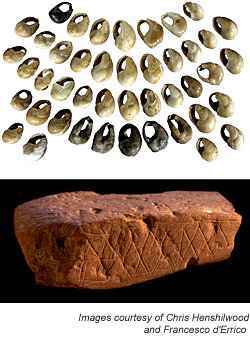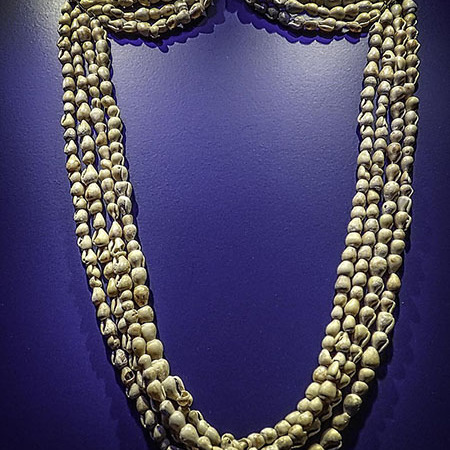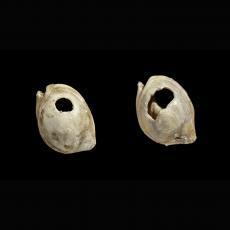Shell Beads and Red Ochre
In 2004, Christopher Henshilwood and Francesco d’Errico’s team shocked the archaeological world with their latest finds from Blombos Cave in South Africa. These included 41 small shell beads, each pierced in the same spot and rubbed with red ochre. The sea snails, Nassarius kraussianus, discovered clustered in groups of the same size and shade, proved to be over 75,000 years old. Wear patterns around the holes suggest they had been strung on cordage or sinew (pictured).

This assemblage is often referred to as a necklace although we don’t know how it was worn or used. It might have been worn around the neck, the wrist, the waist, or included in a headdress or other item of clothing. It could have indicated social status or spiritual power, celebrated a particular event, or been a funerary offering. Or dozens of other possibilities.
Around the world, shells have been used as a form of wealth. Cowries, especially, became so closely associated with wealth that the original Chinese symbol for money was a pictograph of a cowrie shell.
In certain parts of Africa, cowries are prized as charms, said to promise sexual pleasure, fecundity, and good luck. For the Mende people of West Africa, the cowries symbolize womanhood, fertility, and wealth. On the Fiji Islands, the golden cowrie shell was drilled and worn on a string around the neck to mark high rank. The shells can have spiritual significance as well, such as representing Lakshmi, Hindu goddess of wealth, fertility, power, and beauty.
Photos: top row: ancient pierced shells, shell divination board, Lakshmi shells, shell neclaces; bottom row: Ahsta chama board with cowrie dice, shells in trade, beading with shells, and shell bead strings








Interestingly, snail shells were also widely used in gaming. A group or string of shells would be thrown, like dice, with the open (“female”) sides counting toward the score. This may help explain the personification of luck as female (“Lady Luck”).
Like dice, the shells could also be used for divination. A string of shells would be thrown and a “reader” would interpret the resulting combination of shells landing up or down, much like someone reading Tarot cards or tea leaves.
It’s impossible to know whether the people who first pierced these shells in Blombos Cave saw them in these ways, but the examples introduce some common themes to consider.
Red Ochre
A block of red ochre was found with the beads in Blombos Cave. Red ochre, a reddish mineral containing iron oxide, occurs in any environment where iron minerals have pooled and solidified. If you handle it, it stains your hands and clothes. If you have “hard” water, the iron turns your bathtub orange.
The Engraved Block

More than 8,000 pieces of red ochre were recovered from Blombos Cave’s Middle Stone Age levels. Many show use-wear marks, but the block discovered with the beads proved to be much more interesting because it was purposely engraved. The marks include three horizontal lines, one near the top, one near the bottom, and one in the middle. Across those lines are multiple diagonal lines that form a diamond pattern. Comparable designs were found on an engraved bone fragment. These, plus others examples from the region and the engraved ostrich eggshells from Diepkloof, are generally recognized as some of the earliest examples of intentional abstract design, a mark of modern human behavior.
Some years after the shell finds, Henshilwood’s team discovered a red ochre “tool kit” for processing red dye in the same cave. It included a shell mixing bowl, remains of a mixture of red ochre clay, fat, silica, and some liquid, plus a stirring stick. The kit is over 100,000 years old.

Red ochre had many uses in the ancient and modern world, including sunblock, insect repellent, leather treatment, mastic, body odor masker (particularly useful for hunters), hair treatment, teeth cleaner, and body paint. The latter is still common in many parts of the world, from war paint to markings used in ritual celebrations. In some cases it has specific meanings, like sexual maturity or clan allegiance. The photo shows a Himba woman with traditional red ochre body and hair decoration. In your local drugstore, you can find dozens of products using red ochre. Iron oxide compounds are one of the leading ingredients in make-up “blusher.”
Red ochre is associated with intensity: life, death, blood, power, and sexuality. It’s often found in ancient grave sites, laid down under the body and/or sprinkled on top. Mixed with a binder such as blood, urine, or egg, it could be daubed onto walls with fingers or sticks, painted on hands to make prints on walls, brushed onto hides, or blown over an outstretched hand to make a negative handprint. These are found all over the world.

“Sudden Advancement”
The Blombos shells and ochre finds were shocking because they challenged the Sudden Advancement theory of human history. After 1858, when Darwin published his theories about how humans evolved from the great apes by a process of natural selection, people simplified his work into a “survival of the fittest” model, which assumes that the current model is the best simply because it has outlasted its rivals. Later scholars amended this theory to something closer to Survival of the Luckiest, but the earlier version proved too appealing to certain groups to yield to change.
Western academics applied this model to recent human history as well, maintaining that while Homo sapiens arose in Africa about 200,000 years ago, culturally modern humans appeared only about 40,000 years ago, in Europe. Their arrival coincided with a period of accelerated advancement in social and cognitive behavior. That explained the great discoveries in Europe, the vulture bone flute (35,000 years old, Germany), the lion-headed figurine (40,000 years old, Germany), and the fabulous cave paintings of Chauvet (30,000 years ago, France) and Altamira (35,000 years ago, Spain). (All dates are simplifications of a whole range.) These humans were seen as the end product of a long series of advancements in the Darwinian sense. They stood at the front of the line in the March of Progress chart (shown). Implied is a linear sequence, showing the figure in front, the White male, as the culmination of advancement that began with the distant ancestors in Africa.

Except that new finds have challenged that progression. We now know that the oldest examples of cave paintings featuring animal forms are in Indonesia, not Europe, and the oldest known graphic engraving was a zigzag pattern carved on a shell found in Java, also part of Indonesia, and dating to 500,000 years ago.
The oldest cave paintings in Europe may be the work of Neanderthals, not Homo sapiens. Or perhaps the meeting of the two lines spurred competition and creativity on both sides.
Neanderthals were described as stupid and inferior in the Sudden Advancement theory, but that’s proving to be increasingly untrue. The famous eagle-talon “necklace” discovered in Krapina, Croatia, is 130,000 years old, the work of the Neanderthals whose remains were found in the same level of the rock shelter. Each talon was pierced and smoothed, and bits of cordage remain on one, suggesting they were strung together. Red and yellow minerals were identified on the fiber and one of the talons. According to Davorka Radovcic and other authors of the PLOS paper on the talons, “These remains clearly show that the Krapina Neandertals made jewelry well before the appearance of modern humans in Europe, extending ornament production and symbolic activity early into the European Mousterian period.” (The Mousterian or Middle Paleolithic Era was from 160,000 to 40,000 before the present.)
While it was once thought that Homo sapiens and Neanderthals could not interbreed, we now know that they could and did, multiple times, and the offspring were at least sometimes viable. That’s why Neanderthals contributed between 1% and 4% of our genome. Curiously, Neanderthals also mated with Denisovans in East Asia, and these hybrids mated with Homo sapiens. There seem to be other, less well-defined populations also involved in the mix.
The Sudden Advancement/March of Progress model, now sagging under the weight of new evidence, isn’t just inaccurate. It perpetuates a certain brand of toxic regionalism and White supremacy.
The Mystery

Several years after the original Blombos Cave discoveries, researchers found a closely related species of shells: Nassarius gibbosulus, each one pierced and covered with red ochre, dated to 100,000 years old. But these were in what is now Skhul, Israel, thousands of miles from the Blombos site.
In Oued Djebbana, a site in Algeria dating to at least 100,000 years ago, researchers found shells of the same sea snail, Nassarius gibbosulus, each one pierced through the back. The site is 190 kilometers (118 miles) from the sea, so the shells had to be collected and transported to the site, suggesting they had great value. Francesco d’Errico, of Blombos fame, studied them. He found that, like the shells at Blombos, these tiny sea snails were carefully pierced in the same place. D’Errico found them to be a physical demonstration of the makers’ sophisticated language, another marker of modern human behavior. “Personal ornaments are a powerful tool of communication,” D’Errico said. “They can indicate social or marital status, for example. But you need to have a complex system of language behind that. To me [these beads] are very powerful archaeological evidence that these people were able to speak like us.” (South Africa and Algeria shown on map, right)

Why did folks at these three sites happen to process these shells in this particular way – at approximately the same time in the distant past? It’s possible that it’s simply coincidence: that the three groups valued and processed these tiny shells in the exact same way in such far-flung locales. But it seems unlikely.
If it isn’t coincidence, it indicates either a vast trade network that ranged from the bottom of Africa to the Mediterranean, at least 4,200 miles (6890 kilometers), a formidable distance – or exposure to the practice by an even earlier group. There is evidence that ancient groups in East Africa had, by 320,000 years ago, begun trading with others some distance away, using color pigments like manganese and ochre, and manufacturing more sophisticated tools, including obsidian blades sourced from sites up to 50 miles away. However, there’s no clear evidence that this network extended as far as the southern tip of Africa or to the Mediterranean Sea.
That leaves the possibility of a yet-undiscovered network or the idea that an older group passed along the practice. If migration of groups was a gradual process rather than a one-time event, it makes sense that others, like Neanderthals, would have passed through these sites in northern Africa.
Recent discoveries at the Maastricht-Belvedere site in The Netherlands push Neanderthal use of red ochre back to at least 200,000 years ago. Maybe Neanderthals gave Homo sapiens the idea.
It’s an interesting possibility. They had a long history, from about 400,000 years ago to about 40,000 years ago. They spread from Africa into Europe and East Asia. Along the way, they developed ways to survive and thrive in various environments. They controlled fire, made clothing and cordage, lived in shelters, had a range of stone knapping techniques, painted marks on cave walls, and made symbolic/ornamental objects, such as the eagle talon necklace. They buried their dead, sometimes with red ochre and flowers. We have evidence of Neanderthals using boats to cross the Mediterranean Sea more than 100,000 years ago to Crete and several islands off the coast of Greece. We know they valued certain items that were hard to procure and used red ochre extensively.
The Work of Even Older Groups
But even if Neanderthals brought the idea of red ochre and shells to other groups on the shores of the Mediterranean, the practice probably didn’t begin with them either. It appears that each group picked up ideas from their predecessors, then embellished them. If that’s true, the group putting red ochre dye on shells in Blombos Cave and the groups doing the same thing on far-flung sites on the Mediterranean coast had already been exposed to the practice for generations. That’s not to say it meant exactly the same thing to all three groups, but it was very probably familiar.
It’s seems clear that we are hybrids who learned from those who came before us and then put our own spin on it. We are the Shell Beads and Red Ochre People, with a long, complicated, and fascinating history.
Sources and interesting reading:
Bar-Yosef Mayer, Daniella, et al, “Shells and Ochre in Middle Paleolithic Qafzeh Cave, Israel: Indications for modern behavior” Journal of Human Evolution, 56 (2009) 307-314, available at Science Direct
“Blombos Cave,” Wikipedia, https://en.wikipedia.org/wiki/Blombos_Cave
CNRS. “Oldest pigment factory dates back 100,000 years,” Science Daily, 19 October 2011, www.sciencedaily.com/releases/2011/10/111019154507.htm
“Cowrie-shell divination,” Wikipedia, https://en.wikipedia.org/wiki/Cowrie-shell_divination
D’Errico and others, “Early evidence of San material culture represented by organic artifact from Border Cave, South Africa,” PNAS, 14 August 2014, 109 (33): 13214-13218, https://www.ncbi.nim.nih.gov/pmc/articles/PMC3421171/
Duarte, Carlos, “Red ochre and shells: clues to human evolution,” Trends in Ecology & Evolution, October 2014, https://www.sciencedirect.com/science/article/abs/pii/S01269534714001761/
Geggel, Laura, “Ochre: The World’s First Red Paint,” Live Science, 20 November 2018, https://www.livescience.com/64138-ochre.html
Glausiusz, “Were Neanderthals More Than Cousins to Homo Sapiens?” Sapiens, 29 January 2020, https://www.sapiens.org/biology/hominin-species-neanderthals/?fbclid=lwAR1QKTfFa5mHhHzDvY0E_
Gosline, Anna, “Ancient beads imply culture older than we thought,” New Scientist, 22 June 2006, https://www.newscientist.com/article/dn9392-ancient-beads-imply-culture-older-than-we-thought/
Hodgskiss, Tammy and Lyn Wadley, “How people used ochre at Rose Cottage Cave, South Africa: Sixty thousand years of evidence from the Middle Stone Age,”PLoS One, 26 April 2017, https://www.ncbi.nim.nih.gov/pmc/articles/PMC5405984/
Hublin, Jean-Jacques, and others, “New fossils from Jebel Irhoud, Morocco and the pan-African origin of Homo sapiens,” Nature, 2017; 546 (7657):289
“Hunting for Ochre,” Yenbena Marrinbidja, YouTube, youtube.com
Kimball, Kathleen, “Red-handed: An Inquiry into the Meaning of Prehistoric Red Ochre Handprints,” World History Connected, Vol 9, No. 2, https://worldhistoryconnected.press.uillinois.edu/9.2/forum_kimball.html
Lesso, Rosie, “Red Ochre: The Color of Survival,” The Thread (blog), 28 April 2020, https://blog.fabric-store.com/2020/04/28/red-ochre-the-color-of-survival/
Livni, Ephrat, “The world’s oldest visual tale was just dated – and it already faces oblivion,” Quartz, 14 December 2019, https://qz.com/1768757/the-worlds-oldest-cave-art-was-just-dated-and-it-faces-oblivion/
“Making Red Ochre Stain,” YouTube, youtube.com/
Marshall, Michael, “Neanderthals were ancient mariners,” New Scientist, 29 February 2012, https://www.newscientist.com/article/mg21328544-800-neanderthals-were-ancient-mariners
Muir, Hazel, “Ancient shell jewelry hints at language,” New Scientist, 16 April 2004, https://www.newscientist.com/article/dn4892-ancient-shell-jewellery-hints-at-language/
“Nassarius gibbosulus,” Wikipedia, https://enlwikipedia.org/wiki/Nassarius_gibbosulus
“Ochre and the Indigenous Culture” Australia, YouTube.com
O’Grady, Cathleen, “Humans aren’t so special after all: The fuzzy evolutionary boundaries of Homo sapiens,” Ars Technica, 9 September 2015, https://arstechnica.com/science/2015/09/humans-arent-so-specia-after-all-the-fuzzy-evolutionary-boundaries-of-homo-sapiens
“Orisha,” Wikipedia, https://wikipedia.org/wiki/Orisha
Photo of carved ochre blocks and designs from South Africa:
Kristian Tylén, Riccardo Fusaroli, Sergio Rojo, Katrin Heimann, Nicolas Fay, Niels N. Johannsen, Felix Riede, Marlize Lombard, “The evolution of early symbolic behavior in Homo sapiens” PNAS, Proceedings of the National Academy of Sciences Mar 2020, 117 (9) 4578-4584; DOI: 10.1073/pnas.1910880117, https://www.pnas.org/content/117/9/4578
Radovcic, Davorka, and others, “Evidence for Neandertal Jewelry: Modified White-Tailed Eagle Claws at Krapina,” PLOS, 11 March 2015, https://doi.org/10.1371/journal.pone.0119802
Roebroeks, Wil and others, “Use of red ochre by early Neandertals,” PNAS, 7 February 2012, https://doi.org/10.1073/pnas.1112261109/
Sarchet, Penny, “Red Lady cave burial reveals Stone Age secrets,” New Scientist, 18 March 2015, https://www.newscientist.com/article/mg22530134-200-red-lady-cave-burial-reveals-stone-age-secrets/
Smithsonian. “Scientists discover evidence of early human innovation, pushing back evolutionary timeline: Evidence of innovation dates to a period when humans faced an unpredictable and uncertain environment, according to three new studies.” Science Daily, 15 Marcy 2018, www.sciencedaily.com/releases/2018/03/180315140733.htm/
Sykes, Rebecca Wragg, KINDRED: Neanderthal Life, Love, Death and Art. London: Bloomsburg Signa: 2020
“Shell Beads from South African Cave Show Modern Human Behavior 75,000 Years Ago, National Science Foundation New Release 04-048, https://www.nsf.gov/new/new_summ.jsp?cntn_id=100362
Nassarius shells photos: Christopher Henshilwood and Francesco d’Errico
Tarlach, Genna, “What the Ancient Pigment Ochre Tells Us About the Human Mind,” Discover, 15 March 2018, https://www.discovermagazine.com/plant-earth/prehistoric-use-of-ochre-can-tell-us-about-the-evolution-of-humans/
Whitehouse, David, “Cave colours reveal mental leap,” BBC News, 11 December 2003.
Wreschner, Ernst, and others, “Red Ochre and Human Evolution: A Case for Discussion {and Comments and Reply] Current Anthropology, The University of Chicago Press, Vol. 21, No. 5
 newest »
newest »
 Interesting and informative, as always. Love your blog posts.
Interesting and informative, as always. Love your blog posts.





